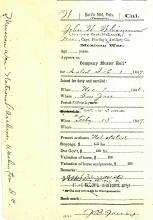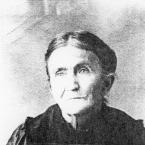
John Washington Whisman was born in 1806 in Lee County, Virginia. He was the son of Phillip E Whisman (1776-1857) and Mary Ann Copenhaver (1780-1850). John had at least seven siblings: Elizabeth (born 1800). Sara Sally (born 1806), Mary K (born 1810), William Michael McCheaf (born 1814), Albion Alvin (born 1814), David Crockett (born 1819), and Lavina (born 1823).
John (age 37) married Ann Margaret King (age 32) in Platte County, Missouri, on November 7, 1843 They had six children over the course of eleven years: Mary Elizabeth (1840-1909), Juliana (1841-1924), Nancy Alameda (1844-1917), John Sutter (1846-1924), Joseph Palmer (1849-1931), and Frances Margaret (1851-1870).
In 1846, John, his wife Margaret their three children Mary, Julianna, and Nancy, where living in Missouri. John's mother, Mary Ann " Copenhaver" Whisman was living with them. John and Mary had decided to migrate to California with their three children and Johns mother. In April of 1846, they left their home and traveled to Independence, Missouri. There, they found a large gathering of wagons in various stages of preparation to travel west to Oregon or California. John and his family joined a group of these wagons headed for California that would soon become known as the Russell-Boggs wagon train.
When the wagon train departed in early May heading west along the Oregon/California trail, John's wife Margaret was four months pregnant. The wagon train soon divided into smaller, more manageable groups. The Whisman's became part of the Campbell wagon group, a group of about fifty people heading to California
The Russell-Boggs wagon train traveled the traditional route, following the Platt River west to Fort Laramie, which took about forty-two days. From Fort Laramie, they traveled west up the the North Fork of the Platt River, west to the Sweetwater River, over South Pass and to the Little Sandy River. The travel to the Little Sandy River took 22 days from Fort Laramie.
At the Little Sandy River, the Donner wagon train group, traveling with the Russell-Boggs wagon train, decided to take a new (untried) route, which was rumored to reduce the distance to California by as much as several hundred miles. The Donner party and many other wagons and individuals decided to part ways with the Russel-Boggs wagon train and take the new route. The new route turned out to be unsuitable for wagons and delayed the group by almost a month. the delay was a major factor causing them to be trapped by snow in the Sierra before they could reach their Sutters Fort.
The remainder of the Russel-Boggs wagon train continued on their planned route . They took the Greenwood/Sublet cutoff, continued north up the Bear River to Fort Hall, eighteen days after leaving the Little Sandy River. From Fort Hall, the wagon train traveled west, down the Humboldt River to the Humboldt Sink, over the forty-mile desert to the Truckee River, over Donner Pass, arriving at Sutter's Fort on October 10, 1846. The entire trip had taken about one hundred-forty days from Missouri.
The Whisman family suffered a tragedy during their journey west. John's mother, Mary Ann "Copenhaver" Whisman, died and was buried somewhere along the trail. However, a joyous event occurred the day following their arrival at Sutters Fort. John's wife Margaret gave birth to their fifth child, John Sutter Whisman on October 11, 1846.
After resting for several days, the weiry travelers prepared to continue to their respective destinations, either the Napa Valley or the Santa Clara Valley.
In April of 1846, the United States entered a war with Mexico, commonly called the Mexican War. Immediately upon arrival of the Russell Boggs wagon train at Sutters Fort, many of the men enlisted to fight with the American forces under Colonel John Fremont. As a inducement for enlistment, each man that volunteered to fight would become eligible for a land grant of 160 acres. Most men joined at Sutter's Fort and their families were moved to the Mission in Santa Clara for their safety. John Washington Whisman enlisted as a private in Captain Findlay's Artilleray Company in San Jose on November 1, 1846. (a copy of his enlistment and discharged can be found in the Gallery below).
(bio is under development, April 4, 2018)


